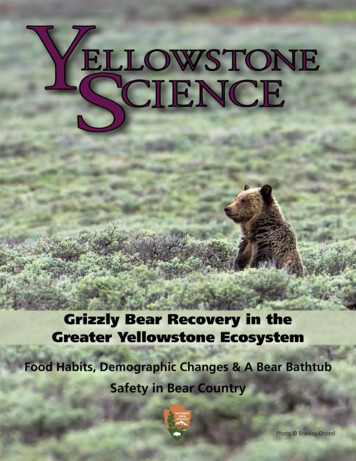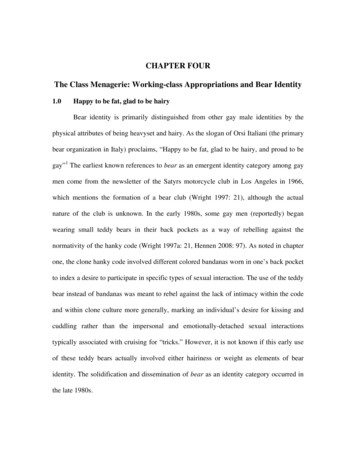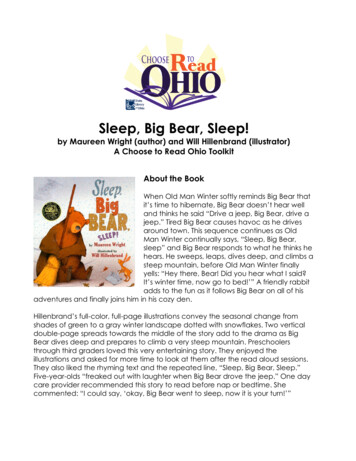
Transcription
SGrizzly Bear Recovery in theGreater Yellowstone EcosystemFood Habits, Demographic Changes & A Bear BathtubSafety in Bear CountryPhoto Bradley Orsted
COPYRIGHT 2014NOT FOR REPRODUCTIONPHOTOGRAPH BY RONAN DONOVANPhoto Ronan DonovanA Celebration of Grizzly BearsWhen I first began working in Yellowstone National Park in the early 1980s, it was fairly uncommon to see a bear,grizzly or black. If you saw a dozen bears in a summer, you considered it a good bear year. Today, you can easilysee a dozen bears in one morning or even on one bison carcass. At present, if you’re in a hurry when drivingthrough the park, you must try to plan your travel route to avoid bear-caused traffic jams. Unlike the “bear jams” of the past,the bears causing traffic congestion today are not seeking human food handouts but are usually seen feeding on natural foodsfound in roadside meadows. Consequently, Yellowstone and Grand Teton national parks have become the premier bearviewing destinations in the lower 48 states. Bear viewing contributes significantly to the economies of park gateway communities, something I never imagined in the early 1980s. Although grizzly bears have increased significantly in numbers andrange, their rate of increase is beginning to slow down in the Greater Yellowstone Ecosystem. This may be evidence they areapproaching their carrying capacity, both biologically and socially.In 2008, an entire issue of Yellowstone Science focusing on grizzly bears was published; it celebrated the removal of grizzlybears from threatened species status as one of the greatest conservation achievements in the history of the United States. Thatissue contained articles on the history of bear management and the controversial closing of garbage dumps in the ecosystem,the recovery and delisting of the species, and how grizzly bears would be managed and monitored after delisting. The issuealso examined habituation, which was predicted to be the most significant bear management challenge moving into the future, as both park visitation and the bear population increased. About a year after the publication of that issue, grizzly bearswere returned to threatened species status by court order, primarily due to uncertainty regarding the future of some bearfoods because of climate change and other factors.In this issue of Yellowstone Science, grizzly bears are once again the featured species. We present recent research on dietarypreferences and the response of bears to changing food resources, demographics of the current greater Yellowstone bearpopulation, and bear habituation to people in national parks. We also present information on grizzly range expansion, cubadoption, consumption of army cutworm moths at high elevation talus slopes, and the risk of a bear attack. In 2015, the U.S.Fish and Wildlife Service is once again considering removing grizzly bears from threatened species status. Whether you arein favor of or opposed to delisting, this issue of Yellowstone Science has something for you. We hope you find the articles interesting, engaging, and scientifically relevant. In contrast to the 2008 issue on bears, which was intended as a celebration ofdelisting, this issue is simply a celebration of bears as a wonderful, remarkable animal and an integral member of the GreaterYellowstone Ecosystem.Kerry GuntherBear Management BiologistYellowstone Center for Resources
Sa periodical devoted tonatural and cultural resourcesvolume 23 issue 2 December 2015Kerry GuntherGuest EditorFrank van ManenMark HaroldsonChris ServheenFEATURES4Forty Years of Grizzly Bear Recovery in theGreater Yellowstone Ecosystem7Grizzly Bears: Ultimate Omnivores of the GreaterYellowstone EcosystemGuest Editorial BoardSarah HaasManaging EditorKarin BergumMarie GoreChristie HendrixJennifer JerrettErik Öberg12How Important is Whitebark Pine to Grizzly Bears?17Demographic Changes in Yellowstone’s Grizzly Bear Population26Response of Grizzly Bears to Changing FoodResources in the Greater Yellowstone Ecosystem33Habituated Grizzly Bears: A Natural Response to IncreasingVisitation in Yellowstone & Grand Teton National Parks41Visitor Compliance with Bear Spray and Hiking Group Size inYellowstone National Park44Yellowstone Grizzly Bear FactsAssociate EditorsCharissa ReidGraphic DesignerDEPARTMENTSSubmissions to Yellowstone Science are welcomedfrom investigators conducting formal research inthe Greater Yellowstone Area. Article acceptanceis based on editorial board review for clarity,completeness, technical and scientific soundness,and relevance to NPS policy.All photos are NPS unless noted otherwise.Please visit our website for further information onsubmitting articles, letters to the editor, viewingback issues, and/or subscription requests: www.nps.gov/yellowstonescience.Correspondence can also be emailed to yellscience@nps.gov or posted to: Editor, YellowstoneScience, PO Box 168, Yellowstone National Park,WY 82190.The opinions expressed in Yellowstone Science arethe authors’ and may not reflect either NationalPark Service policy or the views of the YellowstoneCenter for Resources. Copyright 2015,Yellowstone Association.Yellowstone Science is printed on partial postconsumer recycled paper and is 100% recyclable.47I Am Not a Scientist49Shorts82From the Archives83A Look Back88A Day In the Field90News & Notes96Sneak Peek
Forty Years of Grizzly Bear Recovery in theGreater Yellowstone EcosystemFrank T. van Manen, Cecily M. Costello, Kerry A. Gunther, & Mark A.HaroldsonCOPYRIGHT 2014NOT FOR REPRODUCTIONPHOTOGRAPH BY RONAN DONOVANPhoto Ronan DonovanThe fate and history of grizzly bear populationsin North America are similar to that of otherlarge mammals, and carnivores in particular.Indiscriminate killing and habitat loss took a severe tollon populations in the late 1800s and early 1900s. By the1920s and 1930s, grizzly bears in the contiguous UnitedStates had been reduced to less than 2% of their historical range (Servheen 1999) and by the 1950s had been extirpated from most areas outside of Alaska and Canada(Cowan et al. 1974). In the lower 48 states, grizzly bearsstill persisted in Washington, Idaho, and Montana adjacent to the Canadian border, and in three small isolatedpopulations further south (Cowan et al. 1974). Theseisolated populations included the mountains of Chi-4Yellowstone Science 23(2) 2015huahua, Mexico (the Sierra del Nido and possibly theSierra Madre); the San Juan Mountains of southwestern Colorado; and the Yellowstone Plateau region ofWyoming, Montana, and Idaho, often referred to as theGreater Yellowstone Ecosystem (GYE).Because of its large size, remoteness, and the protections afforded by national park, national forest, and national wildlife refuge lands over a large portion of thearea, the GYE grizzly bear population was the only oneof the three isolated populations that persisted in viable numbers after the 1960s (Cowan et al. 1974). Duringthe following decade, biologists estimated as few as600–800 grizzly bears remained in the lower 48 states.In 1975, grizzly bears in the lower 48 states, including the
GYE, were listed by the U.S. Fish and Wildlife Service(USFWS) as a threatened species under the EndangeredSpecies Act. In 1983, the Interagency Grizzly Bear Committee was formed to help ensure grizzly bear recoverythrough interagency coordination of policy, planning,management, and research. The federal, state, and tribal members of this committee, as well as its YellowstoneEcosystem Subcommittee, initiated various measuresto protect vital habitat and reduce bear mortality in theGYE (see Yellowstone Science, 2008:16[2]). These measures were associated with higher survival, a steady increase in the bear population, expansion of bear range,and recolonization of previously occupied habitats.By the end of the 20th century, the USFWS andthese committees determined that the population hadrecovered and should be moved toward delisting. Oneof the tasks in the 1993 Recovery Plan (USFWS 1993) wasthe preparation of a Conservation Strategy, detailingmanagement and monitoring plans for if and whenthe population was delisted. A final plan was releasedin 2007 (USFWS 2007a); and the USFWS submitteda final rule to delist the Yellowstone grizzly bearpopulation in March 2007 (USFWS 2007b), effectivelyremoving the population from the Endangered SpeciesList. This delisting rule was challenged by a numberof conservation organizations and the Federal DistrictCourt in Missoula, Montana issued an order vacatingthe delisting in September 2009.Protections as a threatened population under the Endangered Species Act were reinstated in March 2010.The USFWS appealed the District Court decision on theprimary grounds that: 1) regulatory mechanisms afterdelisting (i.e., the Conservation Strategy) were adequateto ensure the grizzly population would not decline; and2) the potential loss of whitebark pine (Pinus albicaulis) as a food source would not threaten the GYE grizzly bear population. The 9th Circuit Court of Appealsrendered a decision in November 2011 and reversedthe District Court decision regarding the adequacy ofprotections provided under the Conservation Strategy,but upheld the District Court decision that the USFWShad not sufficiently demonstrated the whitebark pinedecline was not a threat to the Yellowstone grizzly bearpopulation. In response to this court decision, the Interagency Grizzly Bear Committee and its YellowstoneEcosystem Subcommittee tasked the Interagency Grizzly Bear Study Team with conducting a comprehensiveassessment of the current state of knowledge regardingwhitebark pine decline and responses of grizzly bearsto changing food resources in the GYE. This researchbecame particularly relevant given the increasing population trajectory documented at the time.In this issue, we report on the results from several interesting grizzly bear research projects conducted in theGYE, including demographic changes, cub adoptionamong related mother bears, unique bear scent-markingbehavior at a small remote pond, the numeric probability of being attacked by a grizzly bear when backpacking,results of a pilot project using new camera collar technology, and the challenges of managing habituated grizzly bears in the face of increasing visitation in nationalparks. In addition, we take a look back at some unusualattempts at modifying nuisance bear behavior duringthe early history of Yellowstone National Park.Literature CitedCowan, I.M., D.G. Chapman, R.S. Hoffmann, D.R. McCullough,G.A. Swanson, and R.B. Weeden. 1974. Report of the committee on the Yellowstone grizzlies. National Academy of Sciences, Washington, D.C., USA.Servheen, C. 1999. Status and management of the grizzly bearin the lower 48 United States. Pages 50–54 in C. Servheen,S. Herrero, and B. Peyton, editors. Bears: Status survey andconservation action plan. IUCN/SSC Bear and Polar Bear Specialist Groups, IUCN, Gland Switzerland and Cambridge, UK.U.S. Fish and Wildlife Service. 1993. Grizzly bear recovery plan.U.S. Fish and Wildlife Service, Missoula, Montana, USA.U.S. Fish and Wildlife Service. 2007a. Final conservation strategy for the grizzly bear in the Greater Yellowstone Area. U.S.Fish and Wildlife Service, Missoula, Montana, USA.U.S. Fish and Wildlife Service. 2007b. Final rule designating theGYA population of grizzly bears as a distinct population segment and removing the Yellowstone distinct population segment of grizzly bears from the federal list of endangered andthreatened wildlife. 72 FR 14866.YSAcknowledgmentsThe federal, state, and tribal agencies that are members of the Interagency Grizzly Bear Study Team collectively spend a lot of time and effort to monitor and research grizzly bears in the GYE. With the expertise andenthusiasm of 30 to 40 agency personnel and thousandsof hours of field effort each year dedicated to grizzlybear research and management, we have learned a greatdeal about the fascinating ecology of grizzly bears inthe Greater Yellowstone Ecosystem. We are indebtedto our partner agencies for their dedication and foresight to use science-based decision making as a guidingprinciple and for their continued support of the StudyTeam’s research and monitoring efforts: U.S. Fish and23(2) 2015 Yellowstone Science5
Wildlife Service; U.S. Geological Survey; National ParkService; U.S. Forest Service; Wyoming Game and FishDepartment; Montana Fish, Wildlife and Parks; IdahoFish and Game; and the Wind River Fish and Game Departments of the Shoshone and Arapaho Tribes.Frank van Manen is a Supervisory Research WildlifeBiologist with the U.S. Geological Survey’s Northern RockyMountain Science Center in Bozeman, Montana. He is theTeam Leader of the Interagency Grizzly Bear Study Team,an interdisciplinary research team that addresses longterm research needs for management and conservationof the Greater Yellowstone grizzly bear population. Frankearned a M.Sc. degree in Biology from WageningenUniversity in the Netherlands in 1989 and Ph.D. inEcology from the University of Tennessee in 1994. Hejoined the U.S. Geological Survey in 2000 and researchedblack bears, red wolves, Florida panthers, and otherwildlife in the southeastern U.S. He has collaborated oninternational bear research projects with bear researchersin Ecuador, Sri Lanka, China, and Japan. He has servedon the Council of the International Association for BearResearch and Management since 2001, and was electedPresident for two terms during 2007–2013. His currentresearch emphasis is on the changing demographics andecological adaptive capacity of Yellowstone grizzly bears.Photo Bradley Orsted6Yellowstone Science 23(2) 2015
Grizzly Bears: Ultimate Omnivores of theGreater Yellowstone EcosystemKerry A. Gunther, Rebecca R. Shoemaker, Kevin L. Frey, Mark A.Haroldson, Steven L. Cain, Frank T. van Manen, & Jennifer K. FortinBrown bears are widely distributed throughoutEurope, Asia, and North America (Schwartz etal. 2003). In North America, grizzly bears onceoccupied diverse biomes from Northern Alaska southto Mexico and from the Great Plains west to the PacificCoast. Although historic grizzly bear range is much reduced, grizzly bears continue to survive in vastly different landscapes including treeless arctic tundra, borealand coastal forests, mountain forest/grasslands, shrubsteppe, and prairie/riparian habitats. Their ability touse such a wide variety of habitats is attributed to theirintelligence, adaptability, and opportunistic, omnivoregeneralist lifestyle (Schwartz et al. 2003).Yellowstone grizzly bears occupy alpine, subalpine,montane, foothill, and even the edges of prairie vegetation zones encompassing the Yellowstone Plateau ofthe Central Rocky Mountains, referred to as the GreaterYellowstone Ecosystem (GYE). As is typical of mountain ecosystems, food resources for grizzly bears in theGYE are very dynamic, changing from season to season,year to year, and from location to location. In recentdecades, there have been substantial changes in the distribution and availability of several high-calorie foodsused by Yellowstone grizzly bears, such as cutthroattrout and whitebark pine seeds. With potential impactsfrom climate change and other human influences on thelandscape, managers want to better understand howgrizzly bears may respond to future changes in availability of food resources. To do so, one needs to knowwhat foods are currently being consumed and howdiverse their diet is under present-day environmentalconditions. Research on grizzly bears in the GYE hasbeen conducted continuously for over 50 years, likelymaking them the most studied bear population in theworld; although no single study has compiled all data onfoods consumed by GYE grizzly bears. Since no synthesis existed of all foods consumed by grizzly bearsin the GYE, we conducted a review of 49 publishedpapers, 17 books, 4 doctoral dissertations, 11 master’stheses, and 97 state and federal agency administrativereports that have documented grizzly bear food habitsin the GYE during the 124-year period from 1891 to 2014.From this literature we compiled a list of all the reported foods consumed by grizzly bears into one comprehensive document. Grizzly bears will consume almostany fresh, processed, frozen, canned, dried, boxed, orpackaged foods sold for human consumption, includingcamp foods, groceries, beverages, grease, and garbage.We did not include the almost endless list of anthropogenic foods potentially available to GYE bears because,although these foods can provide nutrition for bears,their use most often leads to bears’ lethal removal fromthe ecosystem.Dietary Breadth of the Grizzly BearOur literature review indicated GYE grizzly bearseat an incredibly diverse array of foods, from those aslarge as bison and moose, to those as small as ants and23(2) 2015 Yellowstone Science7
midges. Grizzly bears of the GYE prey on fast and agile animals like elk, but also on slow and relatively immobile species such as earthworms. Some prey speciesfight back and are quite formidable to subdue, which wehave observed when grizzly bears kill adult black bearsor even other grizzly bears. Some insects, such as yellow jackets, put up a stinging defense but are not muchof a threat to bears. Other species like ladybird beetlesand cutthroat trout are relatively defenseless. In addition to prey species, grizzly bears eat many plants andmushrooms. Plants are consumed through grazing, digging, plucking, stripping, and peeling. Grasses, sedges,and clover are grazed; whereas, biscuitroot, yampa, andthistle roots are dug from the soil. Berries are pluckedand stripped from branches and cambium is peeledfrom tree trunks. The foreclaws of grizzly bears areas long as 10 cm (4 inches) (Herrero 2002), and can beused to delicately dig up an individual yampa root orto ‘rototill’ acres of meadows to catch pocket gophersand dig up their food caches of plant roots. The average energy values of the ungulates (6.8 kcal/g), trout (6.1kcal/g), and small mammals (4.5 kcal/g) eaten by grizzlybears were higher than those of the berries (3.2 kcal/g),forbs (2.9 kcal/g), and graminoids (2.5 kcal/g) they consumed (Craighead et al. 1995). At 7.9 kcal/g, army cutworm moths had the highest reported gross energy value of any food consumed (French et al. 1994). Some ofthe plant foods consumed, such as springbeauty, cowparsnip, and clover, are relatively high in protein. Oth-8Yellowstone Science 23(2) 2015er foods are rich in fats, like whitebark pine seeds andbeargrass seed pods; whereas, others provide plenty ofcarbohydrates, such as oniongrass bulbs, yampa tubers,and roots of biscuitroot.In all, we documented more than 266 species in 200genera from four different kingdoms (Plantae, Animalia, Fungi, and Protista) consumed by GYE grizzly bears(Gunther et al. 2014; see a list of the scientific names ofall food items mentioned in this article at: nps.gov/yellowstonescience). Grizzly bears consumed more than162 different plant species (149 native and 13 non-native), including at least 85 forbs, 31 shrubs and berries, 25grasses, 4 sedges, 2 rushes, 4 aquatic plants, and 4 different species of ferns and fern allies as well as cambium,catkins, and nuts from 7 tree species. The primary forbseaten were clover, dandelion, thistle, horsetail, yampa,and biscuitroot. Frequently consumed berries included whortleberry, huckleberry, and strawberry. Themost frequently consumed graminoids were Kentuckybluegrass, sedges, and brome grasses. Seven species ofmushrooms were consumed, including false truffles,puffballs, and morels. We also documented bears feeding on at least 26 mammal, 4 fish, 3 bird, and 1 amphibian species. Additional animal species are undoubtedlyconsumed opportunistically, but have not been documented. The primary mammals consumed were bison, moose, elk, mule deer, pocket gophers, voles, andground squirrels; but mountain goats, marmots, mice,and pikas were also eaten. Grizzly bears consumed at
Grizzly bears will often raid red squirrel middens—large cachesof cones, rich with pine nuts, that the squirrels store for winteruse.least 36 species of invertebrates: primarily ants, armycutworm moths, yellow jackets, and earthworms.Twenty-four different species of ants were eaten including mound, ground, and log-dwelling species. It is easyto underestimate the importance of these insect species;however, ants are one of very few species that have beendocumented in every single grizzly bear scat-based dietstudy in the GYE from 1943 to 2009. Consumption ofone algae (Knight et al. 1978) and one soil type (geothermal; Mattson et al. 1999) were also documented.Although the reason bears eat geothermal soil remainssomewhat of a mystery, the soil may serve to restoremineral deficiencies because it contains high concentrations of potassium, magnesium, and sulfur (Mattson etal. 1999). Finally, grizzly bears consumed 26 species ofdomesticated plants and animals, including 13 species ofcultivated agricultural, garden, and ornamental plants; 7species of domestic livestock; and 4 species of domesticpoultry, as well as domestic dogs and honey bees.Foraging StrategyBecause of their need to accumulate large fat reservesfor hibernation, grizzly bears are energy maximizers(Erlenbach et al. 2014). In grizzly bears, a diet of ap-proximately 20% protein and 80% non-protein energyachieves maximum weight gain per unit of energy intake(Erlenbach et al. 2014, Coogin et al. 2014). To achievethis nutrient target and maximum weight gain, grizzlybears select mixed diets that maximize energy intakewhile optimizing macronutrient intake. This has beendemonstrated in both wild and captive grizzly bears(Erlenbach et al. 2014, Coogin et al. 2014). The diversediets of grizzly bears provides them the opportunity toeat appropriate proportions of nutritionally complementary foods during different seasons and in differentgeographic locations.Whenever available, grizzly bears seek foods of highcaloric value that are concentrated on the landscapeand can be efficiently foraged (Schwartz et al. 2003).Accordingly, frequently used foods included ungulates(bison, elk, moose, mule deer), cutthroat trout, armycutworm moths, and whitebark pine seeds. Bears makeseasonal movements within their home ranges to areaswhere these foods are abundant, such as ungulate winter ranges, elk calving areas, spawning streams, mothaggregation sites on remote talus slopes, and foreststands containing whitebark pine. Most of these foodsare subject to seasonal, annual, and geographic variation in availability, and therefore are not abundant oravailable during all seasons, every year, or within everyindividual bear’s home range. If some of these concentrated high-caloric foods are not readily available,grizzly bears can usually shift their diet to other items,which may have lower caloric value but are widely distributed across the landscape and readily available mostyears. These lower-calorie foods include a wide variety of plants (clover, spring beauty, yampa, biscuitroot,bistort, other forbs, horsetail, grasses, and sedges), colonial insects (ants), fungi (false truffles and mushrooms),berries (huckleberry, whortleberry, and gooseberry),and small mammals (voles, ground squirrels, and pocket gophers). Spatial and temporal abundance and annual predictability of these foods can compensate for theirlower caloric value; and, consequently, these foods cancomprise a large proportion of grizzly bear annual diets(Craighead et al. 1982).Grizzly bears also supplement their diet with manyfoods consumed opportunistically. In fact, most foodswe identified (including a variety of plants, fungi, vertebrates, and invertebrates) were consumed opportunistically with consumption varying annually based on availability and other factors. Opportunistic foods include23(2) 2015 Yellowstone Science9
a variety of species of plants, fungi, vertebrates, andinvertebrates. Some opportunistic foods are consumedonly during a short period each year (e.g., earthwormsin wet meadows at the edge of the receding snowlineduring spring snow melt), while some are available onlyin small, localized areas (e.g., pondweed rhizomes fromsmall ephemeral ponds within the Yellowstone caldera),and others are available only during sporadic periodsof abundance (e.g., yellow jackets, grass hoppers, Mormon crickets, and midges). Many opportunistic foodsare eaten primarily during periods with shortages ofmore preferred foods (e.g., yellow salsify and fernleaflicorice-root) or when randomly encountered whileforaging for other species (e.g., mountain goats, grouse,boreal chorus frogs, and Utah suckers). Some foods oflower caloric value, such as grasses, sedges, and manyforbs, may be consumed in areas between concentrations of higher-quality foods, thereby subsidizing traveland search costs (Mattson et al. 1984).Crow IndianReservationMONTANACuster-GallatinNational ForestBeaverheadDeerlodgeNational ForestShoshoneNational ForestYellowstone National ParkRed RockLakes NationalWildlife RefugeCaribou-TargheeNational ForestJohn D.Rockefeller Jr.Memorial ParkwayCamasNational Wildlife RefugeGrand TetonNational ParkIDAHOBridger-TetonNational ForestNationalElk RefugeWYOMINGWind RiverIndian ReservationFort HallIndian Reservation012.525Grays LakeNational Wildlife Refuge0255050mikm100Occupied Grizzly Bear Range 1990-2010Whitebark Pine StandsCutthroat Trout Spawning TributariesArmy Cutworm Moth Aggregation SitesOccupied Bison RangeGYA State BoundariesNational Park Service (NPS)U.S. Forest Service (USFS)Bureau of Indian Affairs (BIA)Acreage in Greater Yellowstone EcosystemOther 0.12 by Land Management AgencyUSFWS 0.13BIABLM2.5011.56USFSU.S. Fish & Wildlife Service (USFWS)Bureau of Land Management (BLM)Other0.00Occupied Grizzly Bear RangeYellowstone National Park0.421.47NPSGreater Yellowstone Ecosystem5.0010.0015.00Acres (in millions) Figure 1. Distribution of four concentrated high-caloric grizzly bear foods (army cutworm moths, bison, cutthroat trout, and whitebark pine) within occupied grizzly bear range under different land management agency jurisdictions in the Greater YellowstoneEcosystem (adapted from Gunther et al. 2014).10Yellowstone Science 23(2) 2015
Benefits of a Flexible DietGrizzly bears in the GYE exhibit diet flexibility,consuming different foods depending on where theirhome ranges are located (figure 1). Some of the highest-quality foods are not found within all parts of theecosystem and thus are likely not available to all GYEbears (figure 1). For example, army cutworm moths,bison, and cutthroat trout have limited distributions inthe GYE, and even whitebark pine is only available toabout two-thirds of all GYE grizzly bears (Costello et al.2014). Because occupied grizzly bear habitat in the GYEis managed by many different state and federal agencies(figure 1), bears often cross jurisdictional boundaries toforage different food resources. Consequently, interagency cooperation is critical for successful, long-termconservation of grizzly bears and may be particularlyimportant in the face of uncertainties such as climatechange and expanding human occupation of the area.The diet flexibility demonstrated by Yellowstone grizzlybears greatly enhances their ability to occupy diversehabitats over a large geographic area. This diet flexibility likely also enhances their ability to cope with seasonal, annual, and longer-term perturbations in the abundance of high-calorie foods. Knowledge of the dietarybreadth of grizzly bears helps managers of grizzly bearsand their habitat document future changes in patternsof food consumption. This increased understandingprovides managers with a strong foundation for makingdecisions about future grizzly bear management in theGYE.Changing climate and introduced non-native specieswill probably change the species composition and distribution of the plants and animals consumed by GYEgrizzly bears. However, the adaptability and omnivoregeneralist lifestyle characteristics that allow grizzly bearsto occupy diverse habitats throughout the world giveus optimism that grizzly bears are capable of adjustingto these changes, provided that sufficient habitat is pro-tected to allow grizzly bears to adjust to the changes, andhuman-caused mortalities are kept at sustainable levels.Literature CitedCoogan, S.C., D. Raubenheimer, G.B. Stenhouse, and S.E. Nielsen. 2014. Macronutrient optimization and seasonal diet mixing in a large carnivore, the grizzly bear: a geometric analysis.PLoS ONE 9:e97968.Costello, C.M., F.T. van Manen, M.A. Haroldson, M.R. Ebinger,S.L. Cain, K.A. Gunther, and D.D. Bjornlie. 2014. Influence ofwhitebark pine decline on fall habitat use and movements ofgrizzly bears in the Greater Yellowstone Ecosystem. Ecologyand Evolution 4:2004-2018.Craighead, J.J., J.S. Sumner, and G.B. Scaggs. 1982. A definitivesystem for analysis of grizzly bear habitat and other wilderness resources. Wildlife-Wildlands Institute Monograph No.1, U of M Foundation, University of Montana, Missoula, Montana, USA.Craighead, J.J., J.S. Sumner, and J.A. Mitchell. 1995. The grizzlybears of Yellowstone, their ecology in the Yellowstone Ecosystem, 1959-1992. Island Press, Covelo, California, USA.Erlenbach, J.A., K.D. Rode, D. Raubenheimer, and C.T. Robbins.2014. Macronutrient optimization and energy maximizationdetermine diets of brown bears. Journal of Mammology95:160-168.French, S.P., M.G. French, and R.R. Knight. 1994. Grizzly bearuse of army cutworm moths in the Yellowstone Ecosystem.International Conference on Bear Research and Management9:389-399.Gunther, K.A., R.R. Shoemaker, K.L. Frey, M.A. Haroldson, S.L.Cain, F.T. van Manen, and J.K. Fortin. 2014. Dietary breadthof grizzly bears in the Greater Yellowstone Ecosystem. Ursus25:60-72.Herrero, S. 2002. Bear attacks: their causes and avoidance. Revised edition. The Lyons Press, Guilford, Connecticut, USA.Knight, R., J. Basile, K. Greer, S. Judd, L. Oldenburg, and L. Roop.1978. Yellowstone g
Yellowstone Center for Resources . Missoula, Montana, USA. U.S. Fish and Wildlife Service. 2007a. Final conservation strate- . of the tasks in the 1993 Recovery Plan (USFWS 1993) was the preparation of a Conservation Strategy, detailing management and monitoring plans for if and when










